Corals are gorgeous sea creatures that can be any one (or more than one) of the colors of the rainbow–and even some colors that are not! Most of us buy corals when we see them and fall in love, but this guide is intended to help you if you’re looking for specific coral colors to brighten up your tank.
This article is intended to be a starting point for further coral care research, as well as some inspiration for a few of the most popular coral colors you may find out there. Scroll down to get a sense for some of the more and less vibrant color options and click the links to learn more about caring for corals of that type.
Red corals
There are several different types of red corals that are fantastic additions to most reef tanks, and a few that are not. Acan Lords, now re-categorized as Micromussa and Red Plating Montipora corals are two very popular corals that are available in red.
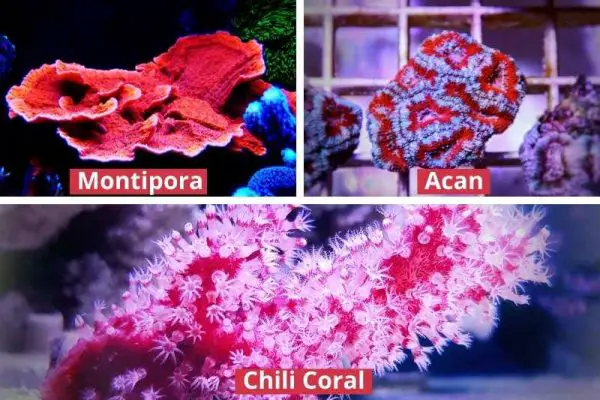
Here is a list of a few coral types that can give your tank a burst of red.
- Red plating montipora
- Mushrooms
- Zoanthids
- Gorgonians
- Acan Lords (Micromussa)
- Blastomussa
- Chili coral
The spectrum of light used to illuminate your tank will have an impact on how red corals look. Under 10,000K lighting, red is red/orange, but under blue actinic lighting, some corals, like the red montipora capricornis will shift towards a red/purple hue.
Red coral colors are created by carotenoids, ommochromes, pterines, purines and favines inside the coral tissue.
Orange corals
You can certainly find the next color of the rainbow, orange, represented in various coral types. Orange coral colors are popular in Ricordea, Zoanthids and Sun Corals. The Orange coral color is created by carotenoid pigments.
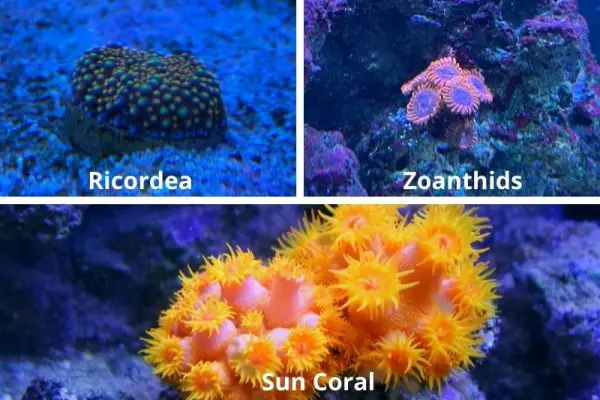
Some corals, like sun corals and even Ricordea (I think) will not really change color much in your tank, but others, like the Leptoseris may be impacted by the amount of zooxanthellae in their coral tissue and teh color temperature of the light.
Under actinic lighting, nearly all orange coral colors are vibrant and really pop, but certain other orange corals may take on a brownish tone under warmer lighting temperatures or lower lighting PAR (because the coral will recruit and retain more brown-colored zooxanthellae in lower light).
Here are a few popular coral species to research that can give you a pop of orange that is so vibrant it looks electric.
- Zoanthids
- Sun coral
- Montipora
- Leptoseris
- Acans
- Ricordea
One watch out with orange colors is that it can drift towards a much less impressive brown color depending on the concentration of zooxanthellae and the temperature of your lights.
Yellow corals
Yellow coral colors are caused by the following types of pigments present within the coral tissue:
- Carotenoids
- Ommochromes
- Pterines
- Purines
- Favines
Pigments achieve various coral color hues based on types of light they either absorb, bend, or reflect. You can see three examples of classic and gorgeous yellow corals in the image below.

The Fiji leather coral is one of my favorite all-time corals. It is a vibrant yellow-colored coral and is bit harder to care for than the average brown Sarcophyton leather. I have such fond memories because it is one of the first corals I grew to a fairly large size in my reef tank–and the colors are awesome.
Certain yellow corals, like Yellow Fiji Leather corals will turn a brownish color under lower light conditions and under warmer light spectra.
There are a lot of other great Yellow coral options, like the list below:
- Yellow Fiji Leather
- Sun coral
- Yellow pagoda
- Yellow turbinaria
- Yellow porites
- Yellow finger gorgonians
- Zoanthids
- Yellow Leptoseris
Green corals
Green is one of the most popular as well as common coral colors among the individuals we tend to see in the aquarium hobby. The green coloration is created by bilines and porphyrines.

One of the things that makes green such a popular coral color is that the green often has a neon-like glow to it that pops out at the viewer under actinic blue lighting hues.
Check out these great coral types that may be available in a green or neon green color for your tank:
- Green star polyps
- Green toadstool
- Trumpet coral
- Green slimer acropora
- Green pocillopora
- Mushrooms
- Goniopora
- Green Plating Montipora
- Zoanthids
- Birdsnest (Seriatopopra)
- Duncan
- Favia/Favites
- Frogspawn/Torch/Hammer
- Ricordea
- Porites
- Chalice
- Pachyseris
- Trachyphyllia
- Lobophyllia
Blue corals
Blue corals owe their hues to flavines, purines and pterines, which are the pigments in their tissue that create the blue colors we see. You can see from the image below that the there are all sorts of different blues to behold among various blue coral types.
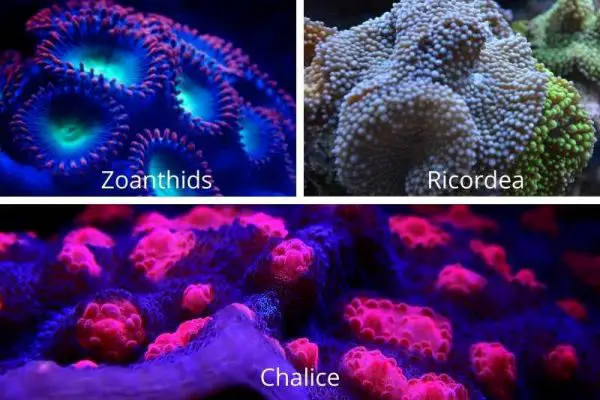
Here are a few great blue coral options for you to consider and research, as you look for the perfect coral for that spot in your tank:
- Chalice
- Ricordea
- Blue Ridge coral
- Zoanthid gardens
- Mushrooms
- Blue Montipora
- Blastomussa
Purple corals
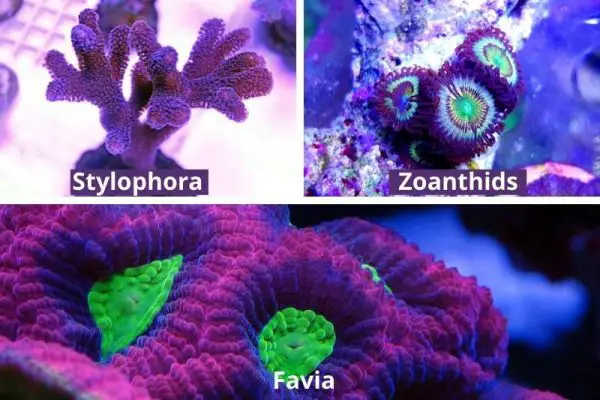
Check out these purple corals:
- Purple People Eaters
- Purple stylophora
- Favia/Favites
- Zoanthids
- Frogspawn/Torch/Hammer
- Chalice
Light Brown/Tan

Brown/tan is potentially the most popular coral color. It is essentially the color of zooxanthellae within the body of the coral. Many of the easiest-to-care-for soft coral species are available in light brown.
- Cabbage leather
- Toadstool leather
- Devil’s hand
- Finger leather
- Pulsing xenia
These coral types are quite frequently the first corals purchased and cared for in a reef tank. Once their care is mastered, many of us try to move up the difficulty chain and color wheel.
White
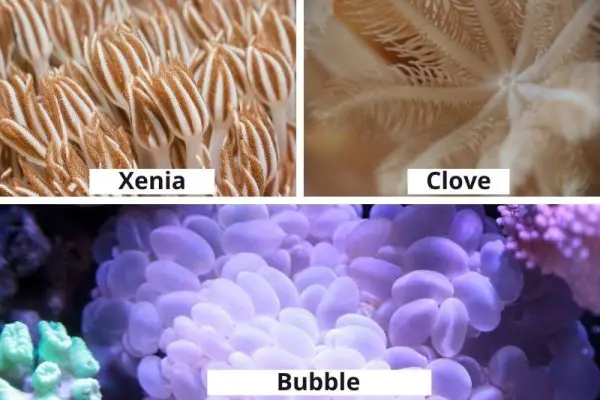
As is common in art, sometimes the absence of things (like color) can also be beautiful. That’s definitely the case in these corals that are actually white:
- Clove polyp
- Xenia
- Bubble coral
If you’re looking for a recommendation, my absolutely favorite white coral is the bubble coral. It is a relatively easy-to-care-for coral and the bubbles look awesome.
Pink
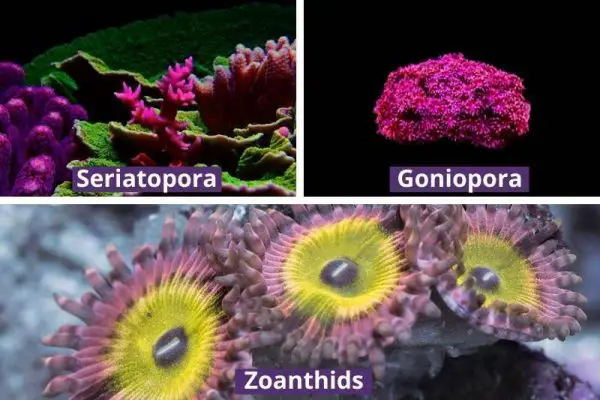
If you’re looking for a show-stopping, stunning color, look no further than these corals that can be found in pink varieties:
- Bird’s nest
- Zoanthids
- Goniopora
What makes corals so colorful?
Coral colors are created by different combinations of pigments and zooxanthellae concentrations in the living tissue of the corals themselves. Pigments either absorb, reflect or refract certain light wavelengths which creates the colors we see when we view the corals.
Photosynthetic zooxanthellae, living in the coral tissues, are naturally a golden brown, which adds a sort of brown/golden tinting to the colors, depending on how many cells are needed to provide nutrition for the coral. In lower light setting, more zooxanthellae are generally present, adding more brown color to the mix, whereas in higher light settings, fewer zooxanthellae are needed, because each cell is more productive, due to the stronger light, and therefore less of the brownish shading is present.
Below is a table with the major coral colors and the associated pigments that assit in creating those colors:
| Coral Color | Pigment | Pigment | Pigment | Pigment | Pigment |
| Red | carotenoids | ommochromes | pterines | purines | flavines |
| Orange | carotenoids | ||||
| Yellow | carotenoids | ommochromes | pterines | purines | flavines |
| Green | bilines | pophyrins | |||
| Blue | pterines | purines | flavines | ||
| Brown | sclerotins | ommochromes | zooxanthellae | ||
| Black | melanin |
If you want to dive more deeply into the topic of coral pigments, check out this scientific article from 2006.
Conclusion
As you could see from the images on this page, corals are amazing creatures that exhibit all of the colors of the rainbow, and then a few more! If you’re like me, you may need to start out with a few of the more plain or common colors, until you gain the skills to keep these generally hardier corals in your tank.
But as your skills progress you will also be able to progress on to some of the more demanding and often times more vibrantly colored coral types.
References
Borneman, E.H. 2001. Aquarium Corals.
Riddle, Dana. 2006. Coral Coloration: Part 3. https://reefs.com/magazine/coral-coloration-part-3-pigments-responsible-for/


Leave a Reply